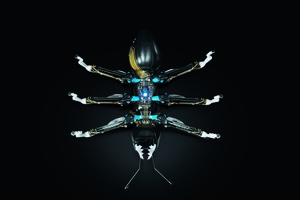
Ants are nature's very own army: goal-driven, indefatigable and capable of great victories in the face of adversity. Now, a German engineering company is looking to harness the power of these insects using the latest bionic technology, in the hope of revolutionising the workforce of the future.
As part of its Bionic Learning Network, Festo has created a swarm of BionicANTs: robot insects around the size of a human hand, which unnervingly resemble a super-sized version of their insect forebears. The BionicANTs are programmed to mimic the intelligence of their real world counterparts -- including their ability to co-operate and complete fiendishly complex tasks, such as moving objects much larger than themselves, which they'd be unable to do alone.

In a press release on its website, Festo says: "Like their natural role models, the BionicANTs work together under clear rules. They communicate with each other and coordinate their actions and movements among each other. The artificial ants thus demonstrate how autonomous individual components can solve a complex task together working as an overall networked system."
Each BionicANT is embedded with a stereo camera in its head and sensors underneath, giving it an intuitive sense of spatial awareness and the ability to locate and grip objects with its pincers. Adding to the robots' uncanny appearance is their 3D-printed plastic body and six ceramic legs powered by piezo technology, which keeps them scuttling along efficiently to get the job done.
 The swarm uses a wireless network to communicate, effectively creating a mini production powerhouse. By using a series of complex algorithms, Festo's vision is to pioneer intelligent robots that could help pave the way for factories of the future run by an entirely autonomous workforce.
The swarm uses a wireless network to communicate, effectively creating a mini production powerhouse. By using a series of complex algorithms, Festo's vision is to pioneer intelligent robots that could help pave the way for factories of the future run by an entirely autonomous workforce.
But how could robot ants actually be used today? Simone Schmid, from Festo, tells WIRED.co.uk: "Piezo-ceramic actuators are now mainly used as pressure sensors and in energy generation; their use in miniature robots is extremely rare."
She continues: "Already today, piezo valves from Festo are used on board vehicles, for example as comfort valves in seats. They are also used in laboratory automation and in medical technology, where they can precisely meter the supply of air and oxygen in mobile respirators. In view of their low energy consumption, their batteries only seldom need changing. Moreover, their switching process is almost silent; this reduces the burden on patients."
But before we humans start getting antsy about these intelligent robots potentially leaving us in the unemployment queue, there's a whole bestiary of bionic animals waiting in the wings. Festo has already turned its hand to creating everything from robotic kangaroos bouncing around on flexible blades to bionic penguins that wouldn't be out of place in the Antarctic.
"Like their natural role models, the BionicANTs work together under clear rules. They communicate with each other and coordinate their actions and movements among each other"
It's not just earthbound creatures that are undergoing a sci-fi metamorphosis either. The Bionic Learning Network recently sent itseMotionButterflies into flight. These ultra-lightweight insects use an intelligent networking system, comprised of ten high-speed infrared cameras. These then track infrared markers on the tiny, 32-gram bodies of the robo-insects, with the data transferred back to a central computer, allowing their movements to be coordinated and preventing mid-air collisions. Each butterfly has a 50cm wingspan and can fly for four minutes.
